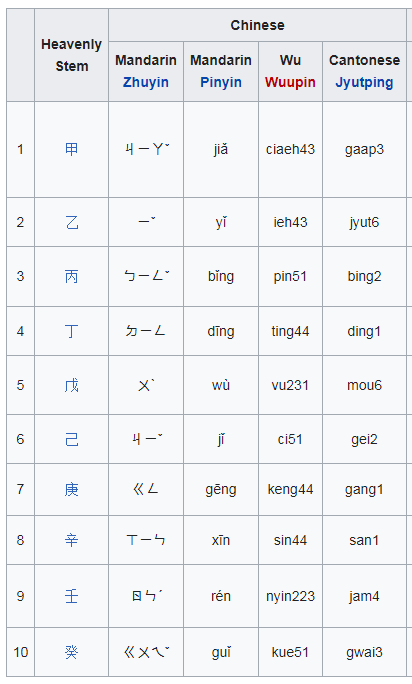So if Chinese written language is picture characters, how do they write complicated words like “methyl hydroxy acetate”?
“Methyl hydroxyacetate” is 羟基乙酸甲酯.

While English uses these prefixes in organic chemistry,
Chinese uses Celestial Stems (天干) instead:

Now the translation of chemical terms:
alkane (-ane) 烷
alkene (-ene) 烯
alkyne (-yne) 炔
acid 酸
carboxylic acid (-oic acid) 羧酸 or 酸
ester (-ate) 酯
hydroxy- 羟基
-yl 基
OK, now that’s enough.
Acetic acid, usually translated to 醋酸 (lit. vinegar acid), has the structure CH3COOH , so it is systematically called ethanoic acid, or 乙酸 in Chinese.
eth- 乙
-oic aid 酸
Therefore, ethanoic acid is 乙酸。
Then, let’s translate “hydroxyethanoic acid” into Chinese.
The structure is HO-CH2-COOH .
Therefore, the Chinese name is 羟基乙酸。
Next, let’s translate “methyl”, with the structure CH3- .
meth- 甲
-yl 基
Therefore, “methyl” is 甲基。
Finally, let’s translate “methyl hydroxyacetate” into its systematic name – “methyl hydroxyethanoate”, with the structure HO-CH2-COO-CH3 .
The Chinese translation of ester is in the opposite word order as the English names, which means that A-yl B-ate is translated to B酸A酯
Therefore, the Chinese name shall be 羟基乙酸甲酯
Let’s talk about the scientific names in Chinese.
As for chemistry, it is already shown above. The IUPAC nomenclature in English is converted into CCS nomenclature in Chinese. The CCS inorganic nomenclature uses the opposite word order to the IUPAC nomenclature, for example, “carbon dioxide” becomes 二氧化碳 (lit. two-oxygen-ized carbon), but the CCS organic nomenclature uses the same word order as the IUPAC nomenclature, with two exceptions:
(1) Ester: CCS nomenclature uses opposite word order as IUPAC nomenclature, as is shown above, A-yl B-ate is translated to B酸A酯
(2) The order of functional groups: Instead of the alphabetical order as the IUPAC nomenclature, the CIP priority rules are used for the order in CCS nomenclature, because there is no alphabet in Chinese. For example, ethyl- is before methyl- because the alphabetical order is used in the IUPAC nomenclature, but 甲基 (methyl-) is before 乙基 (ethyl-) because the CIP priority rules are used in the CCS nomenclature. Consequently, 3-ethyl-2-methylpentane is translated to 2-甲基-3-乙基戊烷 (lit. 2-methyl-3-ethylpentane)。
As for biology, the Chinese names are just written in plain Chinese, just like 食蚁兽 (lit. anteater), rather than a myrmecophagy or a myrmecophaga. However, when writing Chinese monolingual essays, the Latin scientific names, according to Carl Linnaeus’s binomial nomenclature, are required to be appended to Chinese names when they appear at the first time except the title, so it may look like “食蚁兽 myrmecophaga”. It is just for the convenience of database searching and database indexing, because many essays in China are bilingual, Chinese and English. Even a Chinese monolingual essay requires a bilingual “abstract” at the beginning.
As for other subjects, such as physics, medicine, etc, the terms are extremely plain in Chinese. In physics, “gravity” is translated to 重力, lit. heaviness force, “velocity” is translated into 速度, lit. quickness degree, and “inertia” is translated into 惯性, lit. unchanged nature. In medicine, “tracheitis” is translated into 气管炎, lit. windpipe inflammation, and “bronchitis” is translated into 支气管炎, lit. branch windpipe inflammation.